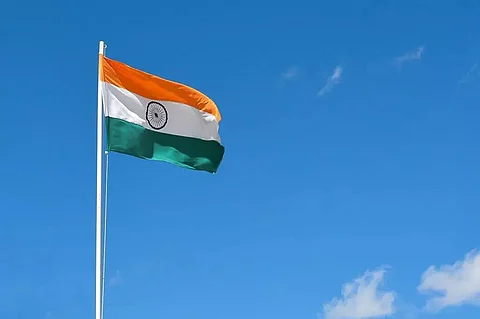
- Home
- Live Blog
- Breaking News
- Top Headlines
- Cities
- NE News
- Sentinel Media
- Sports
- Education
- Jobs

New Delhi: Ever wondered about the illustrious history and significance that our national flag holds? On the eve of the 75th year of India's independence, let us throw some light on the tiranga's evolution and the importance that it holds.
The first thing that strikes our mind when someone says the national flag of India is 'the horizontal tricolours with saffron at the top, dark green at the bottom and white sandwiched in the middle along with a navy-blue wheel in the center of the white band in the middle.
But, there is much more to it.
Before diving into the evolution of the Indian Nation Flag, let us explore all the details and descriptions of the National Flag of India in today's time.
The National Flag is a horizontal tricolour of deep saffron (kesaria) at the top, white in the middle, and dark green at the bottom in equal proportion. The ratio of the width of the flag to its length is two to three. In the center of the white band is a navy-blue wheel that represents the chakra.
The top saffron colour represents the strength and courage of the country, the white middle band indicates peace and truth with Dharma Chakra and the green determines the fertility, growth, and auspiciousness of the land.
Its design is that of the wheel which appears on the abacus of the Sarnath Lion Capital of Ashoka. Its diameter approximates the width of the white band and it has 24 spokes.
Notably, the Constituent Assembly of India adopted the design of the National Flag on 22 July 1947.
It is really astonishing to see the various changes that our National Flag went through since its first inception. It was discovered or recognized during our national struggle for freedom.
The evolution of the Indian National Flag sailed through many phases to arrive at what it is today.
The journey took off in the year 1906 when the first unofficial Indian National Flag was hoisted in the Parsee Bagan Square of Kolkata.
This flag which was composed of three horizontal stripes of red, yellow, and green was also known as the Calcutta flag.
The second flag was unfurled in the year 1907 in Paris by one of the most prominent Indian freedom fighters, Madame Cama along with her band of exiled revolutionaries.
This was also the first time an Indian Flag was being hoisted on foreign soil. Co-designed by Cama, Vinayak Damodar Savarkar, and Shyamji Krishna Varma, it was famously known as the Saptarishi flag.
The third flag was hoisted by a British socialist, Dr. Annie Besant, and the "Father of the Indian unrest", Lokmanya Tilak in the year 1917.
This flag was different from the previous two flags; it had five red and four green horizontal strips arranged alternately, with seven stars in the Saptarishi configuration super-imposed on them.
The Union Jack was placed in the left-hand top corner. There was also a white crescent and star in one corner. This flag, however, was not able to gain popularity among the masses.
The fourth flag was designed in the year 1921 by Pingali Venkayya who was an Indian freedom fighter from the city of Vijayawada of Andhra Pradesh.
It was initially made of two colors- red and green which represented Hindus and Muslims.
However, on the suggestion of Mahatma Gandhi, a white stripe was added to represent the remaining communities of India along with a spinning wheel to signify the progress of the nation.
The fifth flag was adopted in the year 1931 as some people disagreed with the communal interpretation of the flag of 1921; therefore the red color was replaced with saffron which is a symbol of both Hindu yogis as well as Muslim darvesh.
And finally, the Tiranga was adopted on July 22, 1947, after India got independence.
Tiranga is a modification of the flag of 1931 where Charkha was replaced with Chakra and this is how our Indian National Flag completed its journey.
Meanwhile, Indian National Flag is the beacon of hope of countless Indians and is the symbol of national pride. Insulting and disrespecting the national flag is an offense that is punishable under the Prevention of Insults to National Honour Act, 1971.
Originally the Indian National Flag code restriction didn't permit civilians to fly the national flag except on national holidays such as Independence Day and Republic Day.
In 2002, the original Indian Flag Code was amended to allow individuals to hoist the flag on any day, subject to their liberty in protecting the dignity, honor, and respect of the flag.
Also watch: